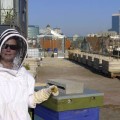Ecosystems include living organisms, the dead organic matter produced by them, the abiotic environment within which the organisms live and exchange elements (soils, water, atmosphere), and the interactions between these components. Ecosystems embody the concept that living organisms continually interact with each other and with the environment to produce complex systems with emergent properties, such that “the whole is greater than the sum of its parts” and “everything is connected”.
The habitat is that geographical unit that effectively supports the survival and reproduction of a given species or of indivuals of a given species; the composite of other organisms as well as abiotic factors therein describe the geographical unit. Other organisms include the plants, animals, fungi, bacteria, viruses and protozoans that also live in a given habitat. Abiotic factors include soil types, water availability, temperature, sunlight, air quality and geometric aspects of landforms that facilitate resting, foraging, nesting, mating, metabolic functions and other activities.biological corridor: connected open greens corridor for the bees, preservation of biodiversity: creating and maintaining biological corridors are important steps towards restoring natural habitats that have been fragmented by natural and human induced processes. By re-establishing and supporting biodiversity, many species are given an opportunity to continue existence in the wild. Conservation organizations continue to research and identify areas that are suitable for these connections, and educate the public about methods of creating habitat corridors.



